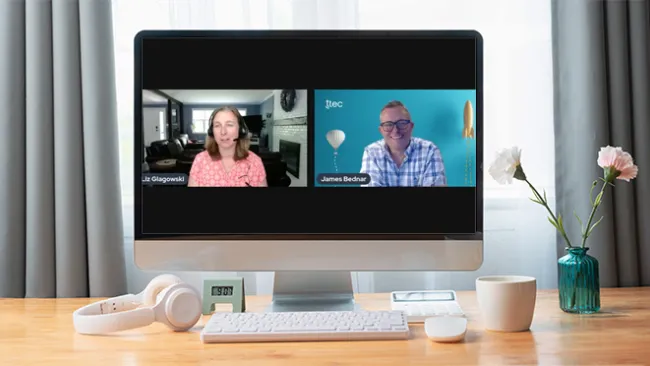In today's climate, companies have a unique opportunity to utilize digital channels to enhance customer conversations and deepen customer relationships. We recently sat down with Sam Rosendorf, senior manager of global enterprise solutions at LivePerson, to learn how organizations can use digital-first technologies like AI and messaging to better serve their customers. No more forcing consumers to wait on hold or navigate complex websites to get answers to questions or to buy products and services. Instead, consumers can get their inquiries resolved using natural language, on the same messaging apps they use to talk to friends and family.
Key takeaways:
- Messaging and automation allows consumers to speak to your business about what they need in the language that they want, in the best way for them, but also in a way that's very efficient for businesses
- Consumers want a great experience, whether that's with a human or a bot, as long as it helps get to a resolution
- Tools enable brands to move quickly and be agile in an uncertain time
Transcript:
Liz Glagowski: Today, we're going to get a little met; we're going to have a conversation about conversations - more specifically, how companies can enable digital tools to enhance customer conversations and deepen customer relationships. So it's a very important conversation that impacts every business, every person, every customer. So I'm pretty excited about this topic today. And joining me to discuss this, to have this conversation about conversations, is Sam Rosendorff, senior manager of global enterprise solutions at LivePerson. LivePerson's a company that works with brands around the world to develop conversational commerce and AI-driven interactions. So I'm very excited to have you with us. Welcome Sam.
Sam Rosendorff: Thank you, Liz. Very excited to be here too.
LG: So as I mentioned, we're going to talk about conversations, and I feel like conversations are kind of the backbone of relationship building. Obviously in both the professional and personal setting, you really need to understand the other person, have a two-way relationship to really build some strength and long-term stability. So I think this really applies in the business setting - that you can use conversations as a way to try to gain that understanding, to listen to people, and to kind of learn customer needs and identify some areas where you may need to make improvements or to build on what works.
So, because a great relationship is built on those conversations, what are you seeing in how brands are using digital technology in ways to create authentic conversations, not just on an individual level, but at scale.
SR: I think something that you've said there really resonates and it's that establishing what the customer needs are. And that's exactly what LivePerson is helping our businesses to do. It's really establishing why that customer is getting in touch to begin with. What is their intent? Why are they reaching out to you? And when they have reached out to you, how can we make that a better experience? How can we make it low-effort? How can we make it something that's memorable for that consumer, but also appreciating the great experience from the brand perspective.
So to answer your question, really what we are doing is working really closely with these brands to redefine their strategy. And if you think about it, we had web strategy at a certain point; then we had app strategies. And now being digital-first isn't really optional. It's something that every single one of our brands is doing. We want to be able to be there when your customer needs you, in a channel that they really would like to speak to you on. And that's what we're enabling through having a conversational strategy or enabling these conversations.
It really is allowing new consumers to speak to your business about what they need in the language that they want, in the best way for them, but also in a way that's really, really efficient for businesses. And so we have a product that allows our brands to connect their agents - whether those are human agents or even bots agents - to their consumers in a really safe and secure way. And alongside that ensure from a business perspective, again, that we are delivering that great experience and that efficiency.
LG: And obviously, you know, in the last few months, since the pandemic really hit, that need to be digital-first is really kicked into high gear. It's accelerated even more than I think companies were sometimes prepared to do. A lot of companies. I'm sure you're seeing, have had to kind of rethink how they're operating internally and also how they're dealing with customers and trying to create those relationship interactions that they were doing maybe in person, they try to recreate those virtually. So what are some ways that you're helping brands first maybe just to react in a digital way, but then also be proactive with these customer interactions in these new ways.
SR: You're absolutely right. I think our brands are having to radically rethink what our normal is. And we're using the words “our new normal” quite a lot. But I think back to just a couple of months ago, it was a very, very stressful time, both as consumers and brands. Everything was unstable. And of course, what that meant was a huge influx in contacts. So not only were brands trying to negotiate what the new normal means for their business, but they also had this influx of contacts, people wanting to get in touch, wanting also to understand what that new normal looks like. And it put immense pressure on their operations.
When you can't have people coming in to the call center, you can't have people coming into the business, that means you're trying to set up homeworking. It means your consumers can't reach out in the way that they're used to. And so we saw with some of our brands, you know, 200 percent increase in contacts; really, really long lines on the phones; and just frustration from customers who were trying to get a simple answer. And I think what stands out to me the most, where we've really been able to help brands react in a different way, is to be smart about where we're offering something that is different to the phone. Something that is different to our first reaction, something we've taught our customers to do: get in line, jump on the phone, wait on hold, and hopefully someone will be there for you soon.
You know, I had a phone call and it was a two hour wait, and we're happy to tell you at the top of the call that you were going to be waiting two hours. And what we do is find a way to divert those customers away from those channels to something where we can help them more. So where I was waiting for those two hours on hold, we could have given them the option to message instead, to press one and then to have a conversation on WhatsApp or through SMS or through Facebook, or any of a myriad of other channels when there was an agent available and when it was suitable for me.
And I think that's a really important point. It's really about speaking to the right person at the right time. And what we found within that, and certainly what we've been building our business upon in the last couple of years, is whether the right person to speak to is always human. Because often I'm really happy to have a great experience, whether that's with a human or whether that's with the bot, as long as it helps me get to a resolution.
And we have really seen a huge increase in the number of automated conversations on our platform. That's more than 50 percent. I think, probably for most of the listeners, you're already bought into the idea of automation. It's something that goes hand in hand with a conversational strategy. You know, really automating where it makes sense, whether that's self-service, whether that's conversation. But what we have seen is, through introducing these opportunities to message, to move away from your old-fashioned channels, into something that is more efficient and more time efficient for your customers.
We're also changing the output there, we're changing the experiences. So just to give you an example, we had a bank who had suddenly 200-plus agents at home who really wanted to be able to help their consumers, but they weren't able to until they had all the right setup at home and they were able to have those conversations. And so what we were able to do is to use what's automation, to use conversational, and to give the power back to these agents by allowing them to, instead of speaking to those customers on the phone, actually do that through messaging. And the reason that that is so powerful is because when you're messaging, you can handle so many more conversations at one time. In fact, you're really, really efficient, usually two times more than what we have on the phone. And that was really, really important when you have a 200 percent increase in contacts. You know, you're going to be looking to drive any kind of a resolution as quickly as possible
And I think when we look at the automation perspective, this is where things really, really dialed up, where we were able to use automation for good. So not just to have the starts of conversations or even sometimes to put contain a conversation, but also to look at what your intent was. We said at the start of this conversation that we would need to understand what the consumer really needs. By understanding that, we could help out brands prioritize: who needed to get in contact first, who needed a response quicker. Was there somebody at risk who needed to be moved up the line? Who needed a quicker response than, say, someone who was just looking to make an admin change. And I think having automation as a tool to support both your agents and your business really, really, really, helps to escalate, if you like that, the power of what conversational can be.
An and so when we talk about being conversational, when we talk about how you could really become digital-first and how you can react and be more proactive, it truly is about allowing those conversations to happen, allowing the technology to support those agents to allow them to work from home. We have a brand who just completely closed their contact centers and they said, ‘We are not going to be doing this; we're going to allow our agents to work from home.’ We had some brands who in a very short period of time were able to train up 200 agents to use messaging and to help deal with those backlogs of conversations. Having automation just checking if those customers in the queue still needed help immediately helped to drive out in some of our brands, like 5 percent of their total queue, which is considerable when it's en masse.
And so what we saw was, where brands were willing to move quickly and where they were willing to really take on board conversation, we were able to make a significant difference in some of those stress points and some of those friction points in dealing with that highest correlation. There's high contact, your stressed agents at home, and really it is just a different, really great way to have a conversation with your brand.
LG: Yeah, there was so many great insights in that answer there. What struck me most is it's really about shifting from the idea of process to the idea of outcomes - where a customer may not care how they get to that outcome, as long as their problem is resolved. Now, I think many brands understand that they have to get there but, especially in the contact center and customer service world, they've been so used to doing certain things a certain way for a long time. So do you have any steps or recommendations of what brands can do tactically to maybe become more conversational, build that relationship strength with some of these digital tools?
SR: Absolutely. I think this time has brought about a need for that more than ever before, where brands really had to be agile. You couldn't necessarily make big strategic-thinking decisions because everyone was really in a position where they were being asked to deliver something very, very quickly. And I think there's a, well, I believe there's four ways we can look at that.
The first is being willing to move quickly, to be agile. Our brands who really handled and were able to switch some of those contacts and really handle great conversations in a conversational way were moving very quickly. So record times switching on new channels, record time training the agents. It's a very simple platform to use, to train on, which is really helpful.
And when we think about what it takes to stand that up, I come from an operational background, I come from a call center background, I'm very familiar with the challenges of training your agents, of defining those processes. And it's an adage that’s used way too often, and I think it's a little bit cliche, but it was so powerful in the context of this, and that's not letting perfect get in the way of progress. And I think that really, really resonates with, we need to start somewhere and I absolutely advocate strategic thinking. There's so much we can do. And we look at truly transforming your brand. And you're thinking that, as you say, it can be quite challenging to know, “Where do I start?”
And I think from my perspective, we can look at that as three main points, it's defining your entry point. So where do we want to move away from the synchronous kind of nature into an asynchronous messaging space? if would we like to do that, is that taking people from the phone? Is that offering QR codes? A great example is these lines that we have now with social distancing is of 20 people that are in line, everyone's waiting to go into the store - or while you're waiting to do that, wouldn't it be great to be able to scan a QR code and then to start having a messaging conversation with someone, so that by the time you make it into the store, you have all the information you need. Suddenly we're moving people through the store a lot quicker, it's a great conversational experience, and we can reengage with those consumers at a later time. And that's one of the examples. There's so many other ways we can do that, but everybody is defining, “Where is the point that we want to start?”
And then, secondary to that is how can we deploy bots and automation? So what can we do to help us scale, to move quickly? And, as you say, it's thinking differently, it doesn't have to replace the entire agent conversation. It can, and it can be brilliant when it's designed to do that, but really it's about finding what is a high-volume, low-complexity use case that we can go after that we can quickly make that shift. And I think a component of that is also, even if you believe in messaging, if you believe in conversational, taking it back to your business and helping your stakeholders believe in your vision and what you see, and having a proof point, having a concept where you can show how quickly messaging can be deployed, how quickly it can make a difference, how amazing it is to be able to jump between automated conversations and agent led conversations. That really helps to have those very, very difficult internal conversations.
And of course, just to add to that last piece, your operational and technical readiness comes alongside that we have done this at scale for so many brands and a huge part of what we do is really not just giving you the product or the software and wishing you luck; it's really talking you through working with your business to establish what you need to do to have that readiness in place for messaging, what you operationally need to do to stand your agents up, that you have the right tools that, you know, we have just the right switch of thinking that it takes to be conversational and.
To summarize, as I said, define those entry points, look at where it could be best to deploy bots and automation, work with your operations teams to get the fundamentals of messaging in place. And it doesn't have to be perfect when you start; you can really spend some time digging into making it a great experience once you've launched. Once you have data to optimize, we have some great tools to support you in that.
LG: Now messaging conceptually, and just digital conversational commerce, it conceptually is a great idea. People are moving away from voice channels, they're using their mobile phones and apps much more. Yet still, there's a lot of brands that are not taking advantage of this as much. So what are some pitfalls or some roadblocks that you may be able to help brands kind of overcome when they're looking to try to do this more?
SR: Absolutely. I think everyone is fighting an internal battle to really deliver the best experience. Everybody wants to create a winning customer experience and delight their customers. And I think part of that is truly embodying that conversational strategy and that automation strategy. With some of our brands there's been a real focus on app strategy or on a particular channel. And at sometimes that's great and we've been able to work with your particular channel of choice to really make that a great experience. But it is also about recognizing at some point that there may be a pivot point. It may be that you want a trajectory to put a couple of hundred agents on the phone, but actually if you repurpose those agents in messaging, these are the different outcomes that you might see. And I think where we tend to see a portfolio's because this is the way we've always done it, we should continue to do it this way. And really messaging is a way to think completely differently about that conversation, about what your customer needs about the processes that need to happen behind the scenes.
And because it's asynchronous because your agent can stop and start the conversation and, in fact, because your customer can stop and start the conversation, we can really redefine what that good looks like. And so my suggestion there, or my advice would be what does good look like for you and your business, and start from there and work backwards. Don't try to fit messaging into the same shape, if you like, that we've always had for our more synchronous channels.
LG: Now, if you were with a brand and you were actually just having an informal conversation about the power of this conversational commerce what would you say would be maybe the first place to start? What would you tell them?
SR: I love that question, cause it's so difficult to define one for, so I'm going to give you two - always, always give more than they expect. So the first piece of advice that I have is that the power truly is in your operations, and messaging being different is really a case of unlearning all of the bad habits that you may have created through asynchronous channel and really allowing your agents and your contact center and your people to redefine what good looks like.
And I guess the second piece for me there is, a piece of advice would really be to be proactive. I look at some of the use cases we've discussed so far today, and they're quite reactive, but the ability to send a proactive message to your consumer to get ahead of the conversation that you are expecting is really, really powerful. We have some brands who are sending what used to be one-way messaging, now two ways. So when you used to receive an SMS on your phone saying, “By the way, you've gone over your overdraft, give us a call don't reply.” What's really powerful is we can change that narrative. And we can say, “If you'd like to discuss this with us, just respond here.” And that becomes really, really powerful because you give the power to your customer to get in touch with you in a channel that they really like. And it has seen phenomenal success. We see really high response rates, over 40 percent, where we do that. For sales use cases, we're seeing considerably higher conversion than over the phone. So I think there's really something to be said for being proactive and just being prepared to think a little bit differently about how we can really serve the intent that that customer is looking for help with.
LG: Well, thank you so much for your insight, Sam. This has been a great conversation about conversations and how they're evolving to meet a lot of the digital needs that we all have these days. Thank you again for all your great insights.
SR: It’s been a pleasure to speak to you. Thank you.














